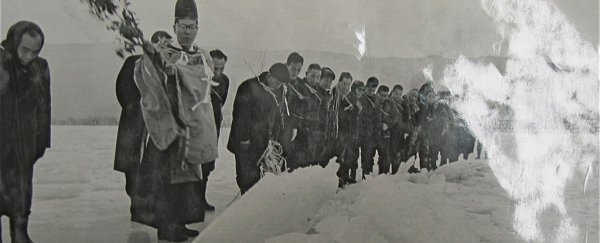Shinto priests from Lake Suwa in the Japanese Alps started monitoring climate data almost 600 years ago, scientists have discovered, by keeping records of the dates when the lake froze during winters going as far back as 1443.
While the priests weren't intentionally logging 'scientific data' per se – the records were part of their observance of a legend about the male god Takeminakata crossing the lake to visit the female god Yasakatome on the other side – their measurements now stand as a valuable early record of climate science, and add further evidence (not that it should be needed) of human-caused climate change in more recent centuries.
"These data are unique," says aquatic ecologist and limnologist, John Magnuson from the University of Wisconsin-Madison. "They were collected by humans viewing and recording the ice event year after year for centuries, well before climate change was even a topic of discussion."
The priests alongside Lake Suwa weren't the only early citizen scientists keeping records hundreds of years ago. Magnuson and his team also found that Finnish merchants started to record ice break-up dates along the Torne River in 1693.
Again, the merchants' objective wasn't so much scientific as it was practical – reflecting the flowing river's importance to trade and transport – but the dates are now relevant for a different purpose, especially in conjunction with the Japanese data set.
"Even though the two waters are half a world apart and differ greatly from one another," said Magnuson, "the general patterns of ice seasonality are similar for both systems."
The Lake Suwa records show that the freeze date shifted at an almost imperceptible rate between 1443 and 1683, moving just 0.19 days per decade later in the year. But once the Industrial Revolution kicked off, the winter frost occurred markedly later, with the date of the lake freezing being pushed back 4.6 days per decade – 24 times faster than the pre-industrial rate.
Half a world away, the Torne River measurements corroborate the evidence of what looks to be early human-caused climate change, with earlier ice break-up dates showing in the Finnish spring.
"Although there are local factors that are influencing both systems," said one of the team, biologist Sapna Sharma from York University in Canada, "climate changes associated with increasing carbon dioxide emissions and air temperatures are important, perhaps overarching factors explaining the trends."
In more recent times, the two data sets show extreme weather events occurring with greater frequency.
For example, Lake Suwa used to freeze over in 99 percent of winters, but now it only does so about half the time – which doesn't just pose problems for Takeminakata crossing the lake. Aside from the more dangerous, long-term consequences of rising temperatures, in these environments, the shift to a warmer climate is already impacting the local way of life.
"Our findings not only bolster what scientists have been saying for decades, but they also bring to the forefront the implications of reduced ice cover," said Sharma. "[D]ecreasing ice cover erodes the 'sense of place' that winter provides to many cultures, with potential loss of winter activities such as ice fishing, skiing and transportation."
The results have been published in Scientific Reports.
